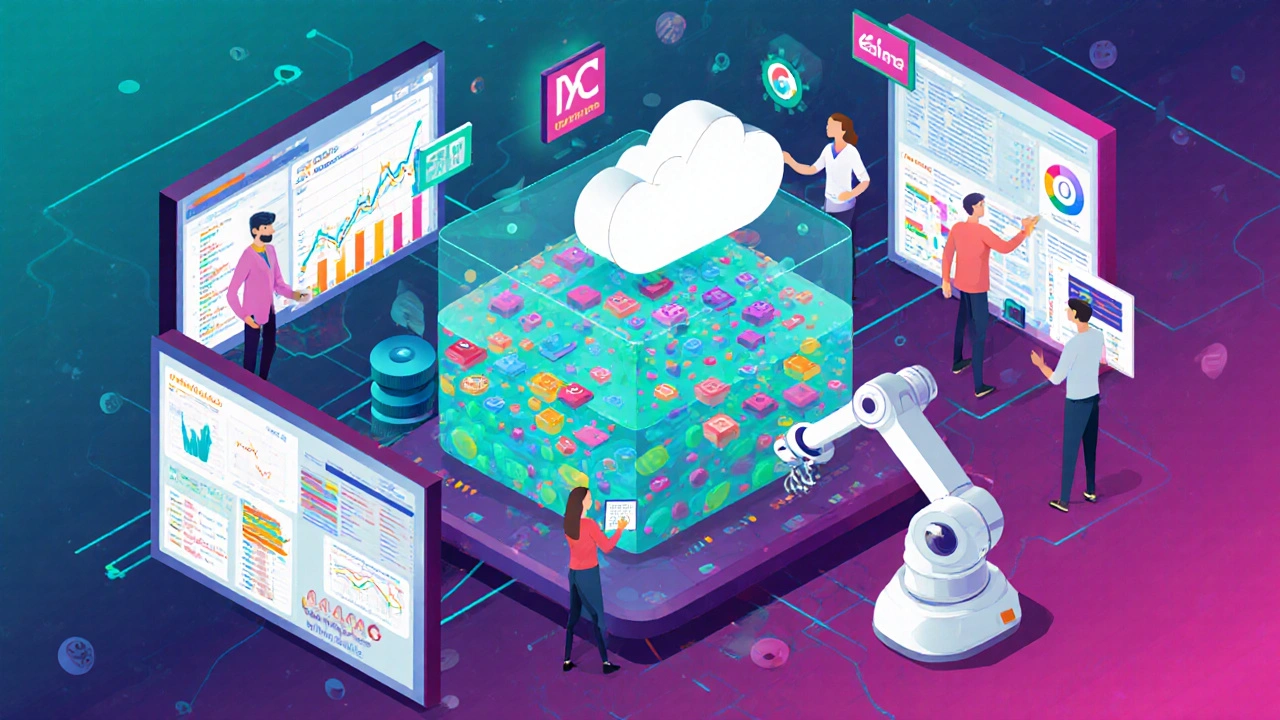AI Demand Forecasting Calculator
Input Historical Sales Data
Predictive Insights
Based on your data, this tool applies linear regression to forecast future sales using AI principles from the article.
Sales Trend Visualization
Linear regression line shows projected growth trend
Businesses chasing growth in 2025 can’t ignore the AI wave. When used right, artificial intelligence reshapes everything from customer service to supply‑chain planning, turning data into profit. Below is a practical guide packed with AI tips that help you turn AI hype into real digital business success.
Why AI is the Engine of Modern Digital Business
Artificial Intelligence is a set of technologies that enable machines to mimic human cognition, such as learning, reasoning, and perception. For a Digital Business - an organization that delivers products or services primarily through digital channels - AI provides three game‑changing benefits:
- Speed: automating routine tasks reduces manual effort by up to 70%.
- Insight: machine‑learning models uncover patterns invisible to humans, fueling predictive decisions.
- Personalization: real‑time recommendation engines increase conversion rates by 15‑30%.
Companies that embed AI early reap higher margins, faster time‑to‑market, and stronger customer loyalty.
Build an AI‑Ready Foundation
Before you chase the latest model, secure three pillars that make AI sustainable.
- Data Strategy: Consolidate silos into a data lake (e.g., AWS S3, Azure Data Lake) that stores raw, structured, and unstructured data in a single repository. Clean, labeled datasets are the lifeblood of any model.
- Cloud Infrastructure: Leverage scalable compute (GPU‑enabled instances) and managed services (Amazon SageMaker, Google Vertex AI) to avoid costly on‑prem hardware.
- Talent & Culture: Blend data scientists, ML engineers, and domain experts. Upskill existing staff through short AI bootcamps focused on practical use cases.
Skipping any of these foundations usually leads to project overruns and low adoption.
Tip 1 - Define Clear Business Objectives First
AI should solve a concrete problem, not just showcase technology. Start with a one‑sentence goal, such as “reduce cart abandonment by 20% using personalized product recommendations.” Map the goal to a KPI (e.g., conversion rate) and set a 3‑month pilot timeline. This focus keeps teams aligned and makes ROI measurement straightforward.
Tip 2 - Start Small with Predictive Analytics
Predictive models are among the quickest wins. Use historical sales data to forecast demand, then adjust inventory automatically. A mid‑size retailer that implemented a demand‑forecasting model in 2023 cut stock‑outs by 25% and saved $1.2 M in carrying costs.
Key steps:
- Identify a high‑impact variable (e.g., weekly sales).
- Choose a simple algorithm (linear regression, ARIMA).
- Validate accuracy with a hold‑out set (aim for < 10% MAPE).
- Deploy via an API that feeds your ERP system.

Tip 3 - Leverage Pre‑Built Models and APIs
Building a model from scratch is rarely necessary for common tasks. Services like ChatGPT (OpenAI’s conversational model), Google Vision, and Azure Speech let you add language understanding, image tagging, or voice transcription with a few lines of code.
Example: a SaaS help‑desk integrated ChatGPT to auto‑suggest answers, cutting agent handling time by 40%.
When using these APIs, keep an eye on latency (under 200 ms for real‑time chat) and cost per 1,000 tokens or image calls.
Tip 4 - Embed AI into Existing Workflows
AI shines when it augments the tools teams already use. Connect a recommendation engine to your e‑commerce platform’s cart API, or plug a sentiment‑analysis model into your CRM to flag at‑risk customers.
- Automation: Use robotic process automation (RPA) together with AI OCR to extract invoice data without manual entry.
- CRM Enrichment: Enrich lead records with predictive scores generated by a machine‑learning model.
Embedding AI reduces friction and accelerates adoption because users see immediate value in familiar interfaces.
Tip 5 - Establish Ethical Governance Early
Bias, privacy, and explainability aren’t optional concerns. Set up an AI ethics board that reviews data sources, model fairness metrics (e.g., disparate impact < 0.8), and compliance with regulations like GDPR and the U.S. AI Bill of Rights.
Publish a simple model‑card for every production model, outlining intended use, performance, and limitations. Transparency builds trust with customers and regulators.

Tip 6 - Track ROI with a Dedicated AI Dashboard
Use Business Intelligence tools (Power BI, Looker) to create an AI performance dashboard that shows:
- Model accuracy over time.
- Impact on core KPIs (e.g., revenue lift, cost reduction).
- Operational metrics like API latency and error rates.
Review these metrics monthly; adjust data pipelines or model hyper‑parameters based on real‑world drift.
Common Pitfalls and How to Avoid Them
| Pitfall | Why It Happens | Prevention |
|---|---|---|
| Insufficient Data Quality | Relying on legacy CSV exports | Implement data‑validation pipelines and maintain a data lake |
| Scope Creep | Adding new features mid‑project | Freeze requirements for the pilot; use a clear KPI sheet |
| Lack of Skills | Hiring only data scientists without domain experts | Create cross‑functional squads; run short AI upskilling sessions |
| Ethical Oversights | Skipping bias checks | Adopt model‑cards and fairness dashboards from day one |
Quick AI‑Implementation Checklist
- ✅ Define one business‑focused AI goal.
- ✅ Consolidate data into a secure data lake.
- ✅ Choose a cloud provider with managed AI services.
- ✅ Start with a low‑complexity predictive model or pre‑built API.
- ✅ Embed the model into an existing workflow.
- ✅ Set up an ethics review board and model‑card documentation.
- ✅ Build an AI dashboard to monitor impact.
Next Steps for Different Personas
For CEOs: Schedule a 45‑minute strategy session with your CDO to prioritize the top three AI use cases that align with revenue targets.
For IT Leaders: Draft a migration plan to move legacy data into a cloud data lake within the next 90 days.
For Data Teams: Prototype a demand‑forecasting model using Python’s scikit‑learn and share a 2‑week sprint roadmap.
What is the first AI project a small business should try?
Start with a predictive analytics use case like sales forecasting or churn prediction. These projects need only historic transaction data and simple models, delivering quick ROI.
Do I need to build my own AI models?
Not always. For many common tasks-text summarization, image tagging, sentiment analysis-pre‑built APIs like ChatGPT, Google Vision, or Azure Speech offer fast, reliable performance with pay‑as‑you‑go pricing.
How can I measure AI’s ROI?
Tie each AI initiative to a specific KPI (e.g., conversion rate, cost‑to‑serve, inventory holding cost). Use a BI dashboard to track the KPI before and after AI deployment, then calculate percentage lift and translate it into dollar terms.
What ethical considerations should I keep in mind?
Check for bias in training data, ensure GDPR‑compliant data handling, provide model transparency through model‑cards, and establish an ethics oversight committee to review high‑risk deployments.
Can AI improve customer support?
Yes. Deploy a conversational AI like ChatGPT to handle first‑line queries, then route complex tickets to human agents. Companies see up to 40% reduction in average handling time.

